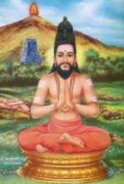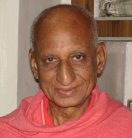

THE ESOTERIC
KANDAR ANUBHUTI
OR
THE SECRET TEACHING ON
GOD-EXPERIENCE
(A Treatise on Adwaitic Realization)
OF
SAINT ARUNAGIRINATHAR

 |  THE ESOTERIC KANDAR ANUBHUTI OR THE SECRET TEACHING ON GOD-EXPERIENCE (A Treatise on Adwaitic Realization) OF SAINT ARUNAGIRINATHAR |  |
 | by N.V. Karthikeyan |  |
| verses contents 32 33 34 35 36 37 38 39 40 41 .. 47 this verse in PDF version (6 parts) p-1 p-2 p-3 p-4 p-5 p-6 complete download of this book |
VERSE-37 கிரிவாய்விடு விக்ரம வேல் இறையோன் பரிவாரம் எனும் பதம் மேவலையே புரிவாய் மனனே பொறையாம் அறிவால் அரிவாய் அடியோடும் அகந்தையையே.Girivaai vidu vikrama vel iraiyon, Parivaaram enum patham mevalaiye Purivaai manane poraiyaam arivaal, Arivaai adiyodum akanthaiyaiye. The Lord, Who threw His mighty Vel on the mountain, Commentary This is a very complicated verse with deep and mystical import. The words used by Saint Arunagiri are intuitive, philosophically profound and have esoteric significance. Mere lexicon meaning of words will not help much to understand the true import of the verse. This is a marvelous verse in which he has packed so much of ideas in a dexterous manner. When the disciple approached his Guru with an earnest longing for liberation and seeks initiation into Sannyasa (verse 36), the Guru, being convinced of his fitness and readiness, initiates him into the Order of Sannyasa. In this process of Sannyasa-initiation, at first a ritual called Viraja Homa (fire ceremony) is performed. In this ritual, the individual offers into the fire, to the chanting of appropriate Mantras, everything of his phenomenal personality -- the body, organs of actions, senses of knowledge, prana, mind, ego, etc.. Then the Guru gives him Upadesa on the Mahavakya, thus initiates him into Nirguna meditation. The Guru tells the student that he is none of those (body, mind, etc.) anymore and that he is pure Consciousness or the Self or Atman or Brahman. He initiates him saying, "Tat Twam Asi" -- "Thou Art That (Brahman)". The disciple is instructed to repeat 'Aham Brahma Asmi' -- 'I am Brahman' and feel that he is Brahman by meditating on this Mahavakya. This is the Mantra or formula for his daily meditation. This Aham Brahma Asmi is what Arunagiri indicates by 'Iraiyon Parivaaram' [(நான்) இறையோன் பரிவாரம்]. (நான்) இறையோன் பரிவாரம் --'Iraiyon Parivaaram': 'Parivaaram' means 'retinue', 'belonging to', 'closely associated with'. 'Iraiyon' means God. '(Naan) Iraiyon Parivaaram' therefore means: I belong to God, i.e. I do not belong to this phenomenal world. The body, senses, etc. belong to the world of matter, to Prakriti, all which have been offered in the Viraja Homa. But 'I' or the Jiva or the meditating consciousness is not matter, it is a unit of consciousness, an integral part of God, the Infinite Consciousness or Brahman. Therefore, it means, I belong to God, I am part of God, I am (part of) God. So it is to meditate: "I am God', 'I am Brahman', 'Aham Brahma Asmi'. It is like the wave telling: I belong to the ocean, I am part of the ocean, I am (part of) the ocean. When the wave abandons its 'wave-ness', i.e. name, form and movement, it is just ocean-water, an integral part of the ocean. Then instead of feeling 'I am the wave', it feels 'I am the ocean'. And it is true. From another point of view we can look at this இறையோன் பரிவாரம் எனும் பதம் -- 'Iraiyon Parivaaram enum padam'. The instruction is to aspire for the status (பதம் -- 'Padam') of being an "Iraiyon Parivaaram" i.e., 'belong to the group of devotees of God, or Yogis or Jnanis'. But who is a Devotee of God, or Yogi or Jnani? Not those who call or think themselves to be so nor those whom the people may call so, but only those whom God regards as belonging to Him. Who are they? They are the God-men. They are those who have attained or realised God, who are established in God-Consciousness, in 'Aham Brahma Asmi'. They are called Jivanmuktas when they are still alive, and Videhamuktas after they shed their bodies. They are the saints and sages; they are the true devotes of God; they are the 'Iraiyon parivaaram'; they are established in 'Aham Brahma Asmi' or "I am Brahman" Consciousness. There is no difference between them and God. So they are called God-Men. They may be Devotee-saints (Naayanars/Aazhwars) or Yogi-saints or Jnani-saints; they only truly belong to God. And God helps the world through them. To those true devotees of God, God and God alone is real, God is all-in-all. Their faith in God is a living faith - a faith which can make God look to their bodily needs, a faith which forces God to appear in the needed manner to remove their sufferings and difficulties, a faith which often draws God to appear before them in person to prove their greatness to the ungrateful world. A study of the lives of saints, especially those of the Sixty-three Nayanar saints and the Azhwar saints of South India will reveal the glory, greatness, and power of such true devotees of God. Gouranga Mahaprabhu, Tulasidas, Ramdas, Jnana-dev, Appar, Sundarar, Jnana-Sambanthar, Sankara, Ramakrishna, Ramana Maharishi, Sivananda, and other Devotees of God (called 'Thondars', in Tamil) could transform people by their mere presence and look. Their company is so purifying, so inspiring and so transforming that a living contact with them will ensure God-vision, even as iron is transformed into gold by the touch of the philosopher's stone. They really belong to God, they are 'Iraiyon Parivaaram'. The instruction of the verse is to aspire to belong to this kind of 'Iraiyon parivaaram'. Such 'Devotees of God' solely engage themselves in the service of God, in His worship, in singing His glories, in repeating His Names, in meditation upon Him, in talking to one another about God and His Lilas; in short, they verily exist for Him and in Him, and nothing other than God exists for them. Only those Thondars, Bhaktas, Yogis, Jnanins, Jivanmuktas who have experienced God, are the real "Parivaaram" of God. Hence, the holy Tamil work 'Periya-Puraanam', which treats of the lives of the Sixty-three Nayanar saints, also goes by the name Thiruth-Thondar Puraanam. The 'Devotees of God' are a category by themselves. They are called Thondars, in Tamil. Thondu means Seva (divine service), and one who has dedicated oneself to the service of God and His devotees is a Thondar. Thondars are servants, in the true sense of the term, who regard themselves as slaves of God and His devotees, and who have dedicated themselves to the service of Temples, Ashrams, etc. They devote their whole lifetime in divine service - cleaning the premises of places of worship, attending to the needs of those that visit temples, maintenance of flower-gardens, wells of the temples, etc., and preparation of garlands and sandal-paste for worship in shrine, etc., etc., all the time immersed in the thought of the Lord. These services they do absolutely voluntarily. They are not employed workers, nor do they restrict their services to a particular temple or place. They keep moving from village-to-village, place-to-place, and do Seva wherever necessary. Though they may be ill-treated by the authorities of the temple and the public because of their untidy appearance which they purposely put on, they keep on doing service. They subject themselves to every kind of humiliation so that there is not the least trace of ego left in them. Thus, the Thondars annihilate their ego, by developing serenity through undivided love for God, which draws His grace on them. Their love of God and genuine eagerness to serve His devotees is known only to the Indweller (God). To them, God alone exists, more so in the form of His devotees. Thus the Thondars are the true 'Devotees of God' -- Iriyon Parivaaram. Does it mean that we are not devotees of God! We regularly visit the temples, do prayer and Puja at home, read scriptures, attend Satsangas, etc. Of course, we are also devotees of God, but only in a secondary sense. Because, the true devotees of God are established in God, their minds are saturated with the thought of God, no other thought arises in their minds. But in our case, though a part of the day is spent in thought of God, a greater part of the day is spent not only in not thinking of God but in such extraneous thoughts and activities of lust, anger, greed, hatred, hypocrisy, etc., of which we would ourselves be ashamed. We belong more to the world than to God. Ramakrishna Paramahamsa used to compare our mind to the fly that sits on and enjoys sweetmeats for a while and the next moment flies away and sits on filth and relishes it. Would anyone be benefitted by belonging to the group of this kind of secondary devotees! Or is the instruction of the verse to aspire to attain that status! எனும் பதம் மேவலையே புரிவாய்: "Enum padam mevalaiye purivaai". 'Enum padam' means that state of 'Iraiyon parivaaram' or 'Aham Brahma Asmi.' 'Mevalaiye purivaai' means to meditate and aspire to attain that state, i.e., to try to get oneself established in the consciousness of "Aham Brahma Asmi." How? By meditation on that Mahavakya. Because, meditation on "Aham Brahma Asmi" will lead to actual experience or realisation of "Aham Brahma Asmi" - Advaita Bhavana leads to Advaita Avastha. Intense feeling leads to experience. Dhyana or meditation leads to Samadhi. 'As you think, so you become.' It is the way of thinking that makes the consciousness either the Jiva or Isvara, man or God, individual or cosmic, bound or liberated. If the principle of awareness in us thinks "I am the body," it verily gets limited to and identified with the body; if it thinks "I am pure consciousness or God or Brahman" it doubtless becomes God, it is Brahman. Hence, when the mind is asked to aspire for the status of being an "Iraiyon Parivaaram," it is an instruction to aspire for and attain the status of Brahman by meditation on "Aham Brahma Asmi", "I am Brahman." Meditation leads to Realization; Dhyana leads to Samadhi. By meditating thus, what happens is explained further in "Poraiyaam arivaal arivaai adiyodum agandaiyaiye" -- பொறையாம் அறிவால் அரிவாய் அடியோடும் அகந்தையையே -- "by the Knowledge or Awareness or Consciousness which is Serenity or Equanimity or Being, destroy the ego-sense with its root, i.e., Ignorance or Ariyaamai." பொறையாம் அறிவு - 'Poraiyaam Arivu': The Guru instructed the seeker to meditate on 'I am Brahman'. But what is Brahman? Or, how to meditate on Brahman? He says, it is 'Poraiyaam Arivu', i.e., Consciousness-Mass or Infinite Consciousness. In the Upanishad, Brahman or the Absolute is defined as 'Prajnaanam Brahma' -- 'Consciousness is Brahman'. It is also one of the Mahavakyas. The Tamil work 'Kanda Puraanam', describing the Avatara or Incarnation of Lord Murugan, says 'பிரமமாய் நின்ற சோதிப் பிழம்பு' - 'Bramamaai nindra jyoti pizhambu' - "The Mass of Jyoti or Light (Consciousness) which is Brahman." (See KAAPPU Verse). Brahman is 'சோதிப் பிழம்பு' Consciousness-Mass; It is a homogeneous Mass of Consciousness i.e., it is Undivided, it is Indivisible, it is Infinite and it is Absolute Consciousness; other than That, nothing else is or nothing else can be. Arunagiri refers to this Consciousness-Mass as பொறையாம் அறிவு -- 'Poraiyaam Arivu'. 'Arivu' is Knowledge or Consciousness (Chit or Prajna). 'Porai' means 'settled' or 'calm' or 'serene' which means Infinite and Indivisible Mass. So "Poraiyaam Arivu" means "Consciousness-Mass" or 'Consciousness-Being' (Chit-Svaroopa), and not 'moving' or 'agitated' or 'limited' or 'Becoming' (Vilaasa). Hence, 'Poraiyaam Arivu' is Serene-Consciousness or Consciousness-Being (Chit-swaroopa) which is Brahman. This is just the opposite of everything of the phenomenal world wherein everything is finite, limited, changing, moving and perishable, i.e. 'becoming'. They are called Consciousness-becoming or Consciousness-play (Chit-vilaasa) which is the phenomenal world. Brahman is 'Being' while the world is 'Becoming'; Brahman is Eternal or Unchanging (Absolute), while the world is changing or relative (finite). So when he is asked to meditate on 'I am Brahman', it is to meditate on 'பொறையாம் அறிவு' i.e., 'I am a Mass of Consciousness, infinite and indivisible in nature'. 'பொறையாம் அறிவு', 'சோதிப் பிழம்பு', and 'Prajnaanam Brahma' -- 'Consciousness is Brahman' -- all mean the same thing. When this meditation on "Aham Brahma Asmi" as 'I am a Mass of Consciousness' is practised by the initiated and well-prepared mind, it settles itself in its substratum, the Indivisible Mass of Consciousness which is called Serenity or 'Being' (Poraiyaam Arivu), by losing its condition of ego-sense or Jivatva or individuality-consciousness, which is "becoming." Just as when a wave-crest subsides, it becomes one with the calm waters of the ocean, the ego-wave of Jiva subsides in the Consciousness-Mass (Brahman), losing its individuality. This Knowledge or Realization of "I am Brahman" or "I am indivisible Consciousness-Mass" is, therefore, a death-blow not only to the ego (individuality-consciousness) but also to its cause, Avidya. Because, there is no place for darkness (Avidya) in that Indivisible Mass of Consciousness or Light. Hence, is the instruction to "destroy the ego with its root" (arivaai adiyodum agandaiyaiye) by meditation on "Poraiyaam arivaal" i.e., "Aham Brahma Asmi." Light does not admit of darkness; Consciousness-Mass does not admit of Avidya. In Light, darkness cannot exist. Even so, in Consciousness-Mass Avidya cannot exist. Meditation on the Absolute is the only way to annihilate the ego and its root, Avidya. Earlier, in verse-28, the aspirant touched the fringe of Cosmic-Consciousness in his meditation, in which his ego was only swallowed up but remained intact. So, he had to return to this illusory world of Maya, as his Avidya, the root-cause of ego, was not destroyed (Ariyaamai poruththilai) (verses 29); and unless Avidya is removed, realisation is not possible. Here is, therefore, the instruction to destroy the ego-sense with its root 'Arivaai adiyodum agandaiyai'. Initiation into Sannyasa itself is not the attainment of the Goal or Anubhuti or God-Realization; it is only a final preparation for it. Now, with this initiation and instruction, the disciple is fully equipped to leap into the Absolute. He has to do intense meditation on "Aham Brahma Asmi", as a Consciousness-Mass, and get established in Brahman or Samadhi. This is evident from the Guru's instruction, following the initiation, to destroy ego with its cause (Avidya) by the knowledge of one's true identity. The verbal instruction given by the Guru to the Seeker in the very initial stage of his Sadhana that he is not the body which gave him a theoretical understanding that he is the Self or Atman (Meipporul pesiyavaa) (Verse-8) is now brought into actual practice or given a concrete shape in the form of Initiation into Sannyasa and instruction to meditate on 'Aham Brahma Asmi'. |
| contents 32 33 34 35 36 37 38 39 40 41 .. 47 this verse in PDF version (6 parts) p-1 p-2 p-3 p-4 p-5 p-6 |
| ... www.kaumaram.com ... The website for Lord Murugan and His Devotees முகப்பு கௌமாரம் அட்டவணை மேலே தேடல் home Kaumaram contents top search |
Kaumaram.com is a non-commercial website. This website is a dedication of Love for Lord Murugan. Please take note that Kaumaram.com DOES NOT solicit any funding, DIRECTLY or INDIRECTLY. |